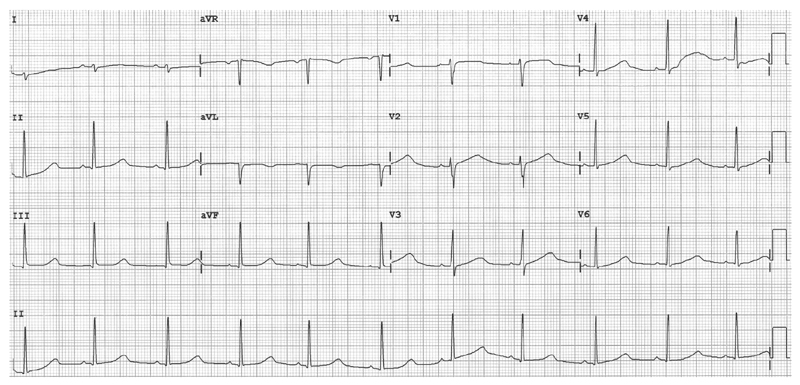Korean Circ J.
2009 Sep;39(9):386-388. 10.4070/kcj.2009.39.9.386.
Epinephrine-Induced Polymorphic Ventricular Tachycardia in a Patient With Congenital Long QT Syndrome
- Affiliations
-
- 1Department of Internal Medicine, Kyungpook National University Hospital, Daegu, Korea. choyk@mail.knu.ac.kr
- KMID: 2225676
- DOI: http://doi.org/10.4070/kcj.2009.39.9.386
Abstract
- A 24-year-old woman presented to the department of plastic surgery for surgical excision of a nevus on her nose. Although her history failed to reveal any cardiac disease, her pre-operative electrocardiogram (ECG) showed an extremely prolonged QT interval of up to 528 msec. Repeated history-taking after admission revealed three syncopal episodes associated with both physical and emotional stress, and because the two-dimensional echocardiography and exercise ECG test were normal except for the prolonged QT interval, an epinephrine test was done to assess QT interval changes after an epinephrine infusion. Immediately after a bolus injection of epinephrine (0.1 microgram/kg), marked prolongation of the QT interval developed, followed by polymorphic ventricular tachycardia which was immediately terminated with direct current shock, resulting in the diagnosis of a long QT syndrome (LQTS), probably type 1. Gene studies were recommended, but declined by the patient and her family. She was instructed to avoid competitive sports, and a beta-blocker was prescribed after which she remained symptom-free.
MeSH Terms
Figure
Reference
-
1. Keating MT, Sanguinetti MC. Molecular and cellular mechanisms of cardiac arrhythmias. Cell. 2001. 104:569–580.2. Kim JH, Nam GB, Kim HK, et al. Clinical and electrocardiographic features of patients with congenital long QT syndrome. Korean Circ J. 2002. 32:798–806.3. Hyun DW, Kim YN, Han SW, et al. Moleculogenetic characteristics of the patient with long QT syndrome in Korean. Korean Circ J. 2004. 34:813–819.4. Moss AJ, Robinson JL, Gessman L, et al. Comparison of clinical and genetic variables of cardiac events associated with loud noise versus swimming among subjects with the long QT syndrome. Am J Cardiol. 1999. 84:876–879.5. Viskin SRU, Sands AJ, Chen E, et al. Inaccurate electrocardiographic interpretation of long QT: the majority of physicians cannot recognize a long QT when they see one. Heart Rhythm. 2005. 2:569–574.6. Shimizu W, Antzelevitch C. Differential effects of beta-adrenergic agonists and antagonists in LQT1, LQT2 and LQT3 models of the long QT syndrome. J Am Coll Cardiol. 2000. 35:778–786.7. Morita H, Wu J, Zipes DP. The QT syndromes: long and short. Lancet. 2008. 372:750–763.8. Schwartz PJ, Priori SG, Spazzolini C, et al. Genotype-phenotype correlation in the long-QT syndrome: gene-specific triggers for life threatening arrhythmias. Circulation. 2001. 103:89–95.9. Ackerman MJ, Khositseth A, Tester DJ, Hejlik JB, Shen WK, Porter CB. Epinephrine-induced QT interval prolongation: a gene-specific paradoxical response in congenital long QT syndrome. Mayo Clin Proc. 2002. 77:413–421.10. Shimizu W, Noda T, Takaki H, et al. Epinephrine unmasks latent mutation carriers with LQT1 form of congenital long-QT syndrome. J Am Coll Cardiol. 2003. 41:633–642.11. Vyas H, Hejlik J, Ackerman MJ. Epinephrine QT stress testing in evaluation of congenital long QT syndrome: diagnostic accuracy of the paradoxical QT response. Circulation. 2006. 113:1385–1392.12. Shimizu W, Antzelevitch C. Cellular basis for the ECG features of the LQT1 form of the long QT syndrome: effects of β-adrenergic agonists and antagonists and sodium channel blockers on transmural dispersion of repolarization and torsade de pointes. Circulation. 1998. 98:2314–2322.13. Jeon IS, Cha TJ, Kim KS, et al. Initiation of torsades de pointes by head-up tilt test in congenital long QT syndrome patient. Korean Circ J. 2000. 30:1040–1044.14. Priori SG, Napolitano C, Schwartz LM, et al. Association of long QT syndrome loci and cardiac events among patients treated with β-blockers. JAMA. 2004. 292:1341–1344.15. Schwartz PJ. Idiopathic long QT syndrome : progress and questions. Am Heart J. 1985. 109:399–411.16. Sauer AJ, Moss AJ, McNitt S, et al. Long QT syndrome in adults. J Am Coll Cardiol. 2007. 49:329–337.
- Full Text Links
- Actions
-
Cited
- CITED
-
- Close
- Share
- Similar articles
-
- Implantable Cardioverter-Defibrillator(ICD) Therapy in a Patient with the Long QT Syndrome
- Fever-Induced QTc Prolongation and Ventricular Fibrillation in a Healthy Young Man
- A Case of Congenital Long QT Syndrome Associated with Deafness and Syncope
- Repeated Aborted Sudden Cardiac Death with Long QT Syndrome in a Patient with Anomalous Origin of the Right Coronary Artery from the Left Coronary Cusp
- Initiation of Torsades de pointes by head-up tilt test in congenital long QT syndrome patient



